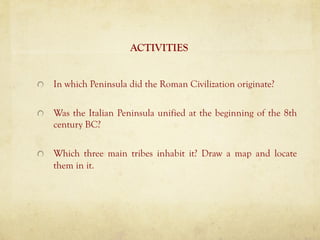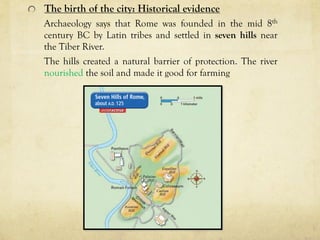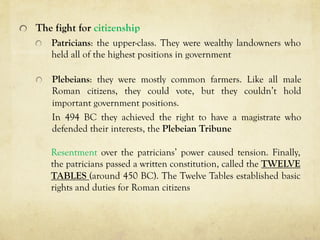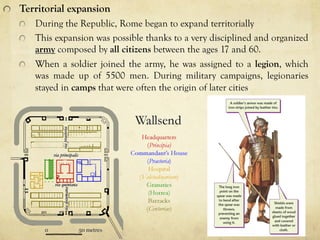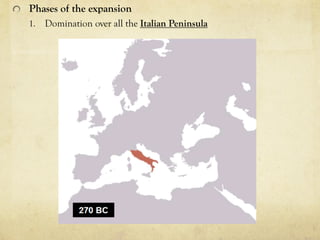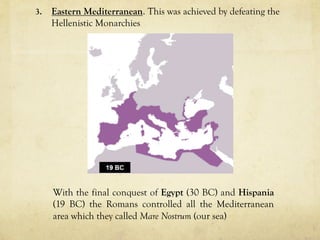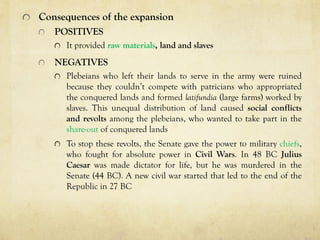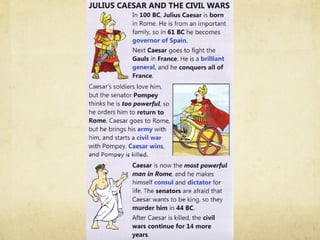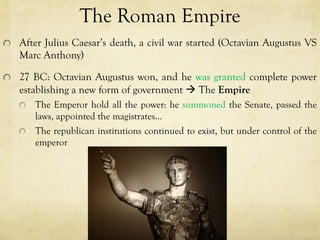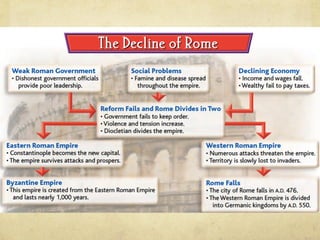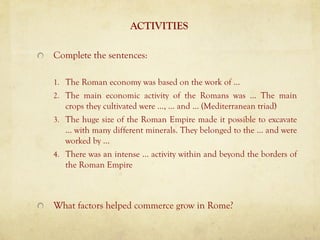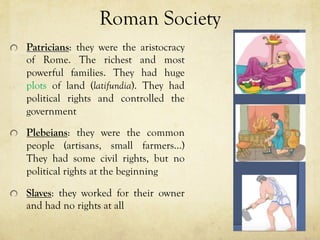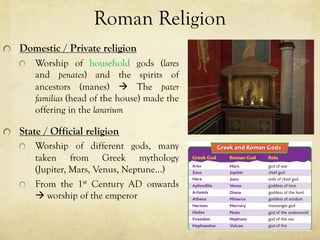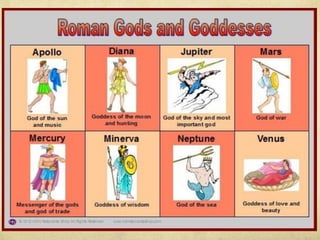2. Ancient Rome
- 1. 2. Ancient Rome 2nd ESO Maira Gil Camarón
- 2. The origin of Rome In the 8th century BC the Italian Peninsula was not unified from a political point of view It was inhabited by different tribes such as: • Etruscans à North. They influenced Roman writing, architecture and alphabet • Latins à Centre. They built Rome • Greeks à South (Magna Graecia)
- 3. ACTIVITIES In which Peninsula did the Roman Civilization originate? Was the Italian Peninsula unified at the beginning of the 8th century BC? Which three main tribes inhabit it? Draw a map and locate them in it.
- 4. Legends: Romulus and Remus – Rome was founded by the twin brothers Romulus and Remus, sons of Mars and a descendant of Aeneas (a hero of Troy), Rhea Silvia. They were abandoned after their birth and they were nursed by a she-wolf and raised by a shepherd. In 753 BC they decided to found a city on one of the Roman hills, the Palatine, where the she-wolf had saved them. After some arguments, Romulus killed Remus and became the first king of Rome Founding of Rome Legends à Romulus and Remus Facts à Archaeological remains and ancient texts
- 5. The birth of the city: Historical evidence Archaeology says that Rome was founded in the mid 8th century BC by Latin tribes and settled in seven hills near the Tiber River. The hills created a natural barrier of protection. The river nourished the soil and made it good for farming
- 6. ACTIVITIES According to historical facts, what is the origin of Rome? Explain it in a paragraph According to the legend, what is the origin of Rome? Explain it in a paragraph
- 8. Roman Monarchy 753-509 BC Form of Government: Absolute monarchy à the king ruled with absolute power There were 7 king in total, the first four were Latin kings, the others had an Etruscan origin. Romulus Numa Pompilius Ancus Marcius Tarquin Priscus Servius Tullius Tarquind the Proud
- 9. In 509 BC the Patricians organised a revolt against the king Tarquin the Proud. He used violence, murder and intimidation to maintain control over Rome and people hated him. Tensions came to a head when his son raped a woman of a patrician family (Lucrecia). As a consequence, the patricians organised a revolt and: Tarquin the Proud was expelled à The end of the Monarchy Patricians established a new form or government: The Republic
- 11. ACTIVITIES What was the first form of government of Rome? Who held the power? How many kings were there during the Roman Monarchy? Name them What happened in 509 BC?
- 12. The Roman Republic The motto of the Roman Republic was Senatus Populus Que Romanus, The Senate and People of Rome It meant that the power was held by the Senate and the People of Rome, not by a a king anymore
- 13. Political changes during the Republic à Power was divided among three institutions: 1. COMITIAS (or POPULAR ASSEMBLIES). They were made up of plebeians, although all the Roman citizens could take part. Their representatives protected the right of plebeians. In the comitias: the magistrates were chosen laws were passed decisions about going to war were taken 2. MAGISTRATES. These were annually elected. Two people were chosen for each position in order to prevent abuse of power. There were not paid for their work
- 14. 3. SENATE. It was a powerful body of 300 members (ex–magistrates) that advised Roman leaders. Most senators were patricians. It was responsible for: deciding foreign policy upholding decisions made by the comitias
- 15. The fight for citizenship Patricians: the upper-class. They were wealthy landowners who held all of the highest positions in government Plebeians: they were mostly common farmers. Like all male Roman citizens, they could vote, but they couldn’t hold important government positions. In 494 BC they achieved the right to have a magistrate who defended their interests, the Plebeian Tribune Resentment over the patricians’ power caused tension. Finally, the patricians passed a written constitution, called the TWELVE TABLES (around 450 BC). The Twelve Tables established basic rights and duties for Roman citizens
- 16. ACTIVITIES What form of government was established in 509 BC after the Monarchy? In this form of government, who held the power? Who elected the magistrates of Rome? Say which magistrate... Administered justice Controlled the army Was in charge of the police Made the list of citizens of Rome Defended the plebeian interests Collected taxes Did patricians and plebeians have the same political rights during all the Republic? Explain it
- 17. Territorial expansion During the Republic, Rome began to expand territorially This expansion was possible thanks to a very disciplined and organized army composed by all citizens between the ages 17 and 60. When a soldier joined the army, he was assigned to a legion, which was made up of 5500 men. During military campaigns, legionaries stayed in camps that were often the origin of later cities
- 18. Phases of the expansion 1. Domination over all the Italian Peninsula
- 19. 2. Western Mediterranean. This was achieved by defeating Carthage in the Punic Wars. They were a series of three long wars against a rich trading city in North Africa. Rome won each of the Punic Wars but almost lost the second. Hannibal, a general from Carthage, crossed the Alps with a herd of elephants and nearly captured Rome. The Roman general Scipio defeated him in 202 B.C. In 146 B.C., Rome finally captured and destroyed Carthage.
- 20. 3. Eastern Mediterranean. This was achieved by defeating the Hellenistic Monarchies With the final conquest of Egypt (30 BC) and Hispania (19 BC) the Romans controlled all the Mediterranean area which they called Mare Nostrum (our sea)
- 22. Consequences of the expansion POSITIVES It provided raw materials, land and slaves NEGATIVES Plebeians who left their lands to serve in the army were ruined because they couldn’t compete with patricians who appropriated the conquered lands and formed latifundia (large farms) worked by slaves. This unequal distribution of land caused social conflicts and revolts among the plebeians, who wanted to take part in the share-out of conquered lands To stop these revolts, the Senate gave the power to military chiefs, who fought for absolute power in Civil Wars. In 48 BC Julius Caesar was made dictator for life, but he was murdered in the Senate (44 BC). A new civil war started that led to the end of the Republic in 27 BC
- 24. ACTIVITIES Explain the phases of the territorial expansion of Rome during the Republic Who fought in the Punic Wars? Who won? What territorial changes did they bring? What were the consequences of the territorial expansion?
- 25. The Roman Empire After Julius Caesar’s death, a civil war started (Octavian Augustus VS Marc Anthony) 27 BC: Octavian Augustus won, and he was granted complete power establishing a new form of government à The Empire The Emperor hold all the power: he summoned the Senate, passed the laws, appointed the magistrates... The republican institutions continued to exist, but under control of the emperor
- 26. Historical evolution of the Empire 1-2nd centuries AD: period known as PAX ROMANA: Maximum expansion of Rome Peace inside the Roman borders Division into provinces ruled by governors to make it easier to control such a huge territory ROMANISATION: process through which the conquered people adopted the Roman culture (Latin language, religion, art, structure of the towns...)
- 28. ACTIVITIES What happened after Julius Caesar’s death? What form of government was established? Who held the power? What is the Pax Romana? What name did the Romans gave to the conquered people? What was Romanisation?
- 29. 3rd century AD à à the end of the territorial expansion caused a deep CRISIS Some reasons that caused the crisis were: First defeats by the Barbarians made frontiers no longer safe, so military chiefs took control in some areas As conquests ended, there were fewer slaves to work, so this caused economic problems: prices increased and trade dropped. This made the empire became poorer, so taxes were increased Due to the economic problems, many people abandoned cities and migrated to the countryside. The empire became ruralised (self- sufficient economy, no trade, no prosperity...)
- 31. 395 AD: to try to solve the crisis, emperor Theodosius divided the empire in two parts: WESTERN ROMAN EMPIRE • Capital: Rome • Evolution: It fell in 476 due to the invasion of the Germanic tribes. Odoacre deposed the last Roman emperor, Romulus Augustus EASTERN ROMAN EMPIRE • Capital: Constantinople • Evolution: It continued existing until 1453 as the Byzantine Empire. Then, it fell to the Turks
- 32. ACTIVITIES Explain the reasons which caused the crisis of the 3rd Century AD What did the Roman Empire do to try to solve the crisis? (say who and when) What caused the fall of Western Roman Empire? Who was the last Roman emperor? Who deposed him? When? What happened to the Eastern Roman Empire after 476 AD?
- 33. Roman economy The Roman economy was based on slaves à they were acquired by Roman conquests of territories and they worked in agriculture and urban activities
- 34. FARMING: The main economic activity. Mediterranean triad: olives, cereals and wines MINING: Gold, silver, iron, coal, copper, tin, lead... Mines belonged to the state and workforce was completely slaves CRAFTWORK: Pottery, textiles, silverware, weapons... Food processing was also important TRADE: There was an intense trading activity within and beyond the borders of the Roman Empire. It was favoured due to: A road network A common currency Standardized weights Control over the Mediterranean Strategic geographic location
- 38. ACTIVITIES Complete the sentences: 1. The Roman economy was based on the work of ... 2. The main economic activity of the Romans was ... The main crops they cultivated were ..., ... and ... (Mediterranean triad) 3. The huge size of the Roman Empire made it possible to excavate ... with many different minerals. They belonged to the ... and were worked by ... 4. There was an intense ... activity within and beyond the borders of the Roman Empire What factors helped commerce grow in Rome?
- 39. Roman Society Patricians: they were the aristocracy of Rome. The richest and most powerful families. They had huge plots of land (latifundia). They had political rights and controlled the government Plebeians: they were the common people (artisans, small farmers...) They had some civil rights, but no political rights at the beginning Slaves: they worked for their owner and had no rights at all
- 40. ACTIVITIES Define patricians and pebelian Design a social pyramid of Roman society
- 41. Roman Religion Domestic / Private religion Worship of household gods (lares and penates) and the spirits of ancestors (manes) à The pater familias (head of the house) made the offering in the lararium State / Official religion Worship of different gods, many taken from Greek mythology (Jupiter, Mars, Venus, Neptune...) From the 1st Century AD onwards à worship of the emperor



